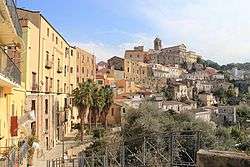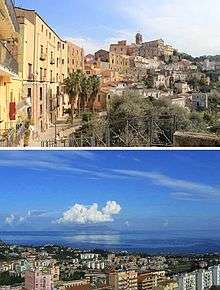Patti, Sicily
| Patti | |
|---|---|
| Comune | |
| Comune di Patti | |
 View of the cathedral and historical centre | |
 Patti Location of Patti in Italy | |
| Coordinates: 38°8′20″N 14°57′55″E / 38.13889°N 14.96528°ECoordinates: 38°8′20″N 14°57′55″E / 38.13889°N 14.96528°E | |
| Country | Italy |
| Region | Sicily |
| Metropolitan city | Messina (ME) |
| Frazioni | Tindari, Case Nuove Russo, Case Nuove Malluzzo, Mongiove, Scala, Moreri, San Cosimo, Madoro, Scarpiglia, Marinello, Gallo, Camera, Provenzani, Sorrentini. |
| Government | |
| • Mayor | Giuseppe Mauro Aquino |
| Area | |
| • Total | 50.18 km2 (19.37 sq mi) |
| Elevation | 157 m (515 ft) |
| Population (31 May 2011) | |
| • Total | 13,379 |
| • Density | 270/km2 (690/sq mi) |
| Demonym(s) | Pattesi |
| Time zone | UTC+1 (CET) |
| • Summer (DST) | UTC+2 (CEST) |
| Postal code | 98066 |
| Dialing code | 0941 |
| Patron saint | St. Febronia |
| Saint day | July 5 |
| Website | Official website |
Patti is a town and comune in northeastern Sicily, southern Italy, administratively part of the Metropolitan City of Messina, on the western shore of the gulf of the same name. It is located 76 kilometres (47 mi) from Messina.
It is connected to the rest of Sicily by train, via the Patti-San Piero Patti train station, located on the railway line Messina-Palermo, and the A20 Palermo-Messina highway. It is still known for the ruins of Tindari, famous for its ancient Greek theatre, and the Villa Romana.
History

It stands near the site of the ancient Tyndaris, a Lacedæmonian colony that had a very flourishing commerce; the magnificent temple of Mercury in the latter city was despoiled by Verres. By the time of Pliny the Elder, the sea had encroached greatly upon the shore, and after the foundation of Patti, Tyndaris was almost entirely abandoned; there remains only the church of Santa Maria del Tindaro, with a Franciscan monastery.
The current town name derives from the name given by its inhabitants after they moved there, following an earthquake that destroyed Tindari, forcing them to find another place to settle. The new site was named Ep' Aktin (Ἐπ' Ἀκτήν, Greek for 'on the shore'), from which the contracted name "Patti" derives.
The city was rebuilt by Count Roger, after the Saracens had been driven from Messina (1058). The town was founded by the Norman king Roger II of Sicily in 1094. Patti is also famous for its large sandy beaches.
Patti was destroyed by Frederick of Aragon about 1300, on account of its attachment to the House of Anjou; rebuilt in the 16th century, it was later sacked by the Ottoman Turks.
Main sights
- Ruins of Tindari
- Remains of a Roman Villa (3rd century AD)
- Necropolises of Monte (10th through 8th centuries BC) and san Cosimo (3rd millennium BC through 9th century BC)
- Cathedral (10th century), housing the sepulchre of Adelasia Countess of Sicily, wife of Roger I.
People
- Michele Sindona, banker and convicted criminal
- Michelangelo Rampulla
- Antonio "Tony" Cairoli.
See also
Sources

- Michele Fasolo, Tyndaris e il suo territorio I. Introduzione alla carta archeologica del territorio di Tindari, Roma 2013, ISBN 978-88-908755-1-9 https://books.google.com/books?isbn=8890875518
- Michele Fasolo, Tyndaris e il suo territorio II. Carta archeologica del territorio di Tindari e materiali, Roma 2014, ISBN 978-88-908755-2-6 https://books.google.com/books?isbn=8890875526
